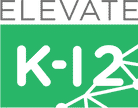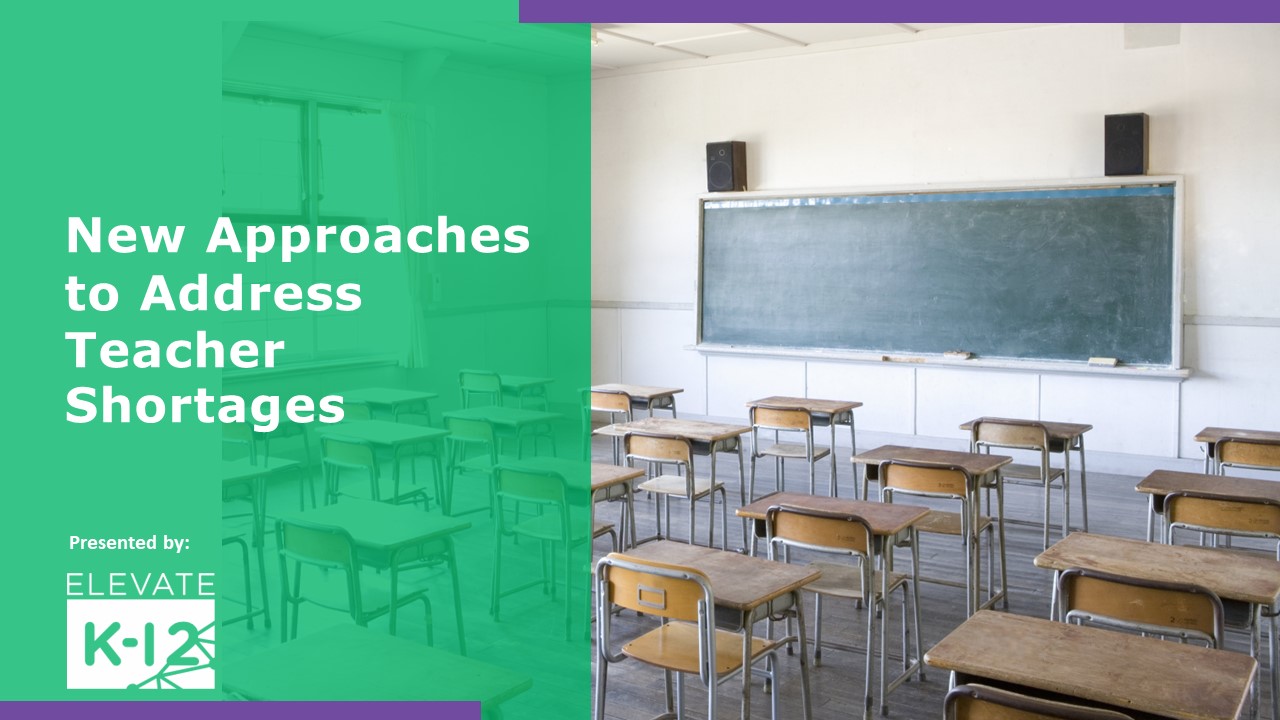Introduction
Steven 00:01
Hello, everyone, and welcome to our district administration web seminar here today, which is entitled, “New Approaches to Address Teacher Shortages.” And all this is brought to you by the generous support of our sponsor with us here today, Elevate K-12. Now, before we get started, I would just like to share just a few housekeeping items, and we’ll get right to the presentation. We will be welcoming any questions you have today with a Q&A session, and that will be happening at the end of the presentation. You can submit a question by using the ask question module that is at the bottom of your screen there. It’s the red button with the question mark. There will also be some audience polls throughout the presentation. And those polls, they will appear as regular slides like in a PowerPoint presentation, you can participate by clicking directly on the slide. Also, there are some clickable and downloaded content that I’d like to direct your attention to the related content module or the blue icon with the paperclip that includes a few assets related to today’s topic, just click to visit the URL or to safely download the assets immediately. There’s also the option to book a meeting options. So, you can reach out directly to Elevate K-12. And that’s at the bottom of your screen, as well. It’s the blue icon with the calendar. And, lastly, final thing, all of you will receive an email at some point later tomorrow from our team here at DA and that email, it will include the on demand video, as well as the presentation slides. And, now, it is my pleasure to introduce our speakers that we have with us this afternoon. We have Dr. Kakela O’Banner Robinson, who is former associate superintendent and Chief of Staff at Marlboro County school district in South Carolina, Kim Kays who is Interim Vice President of Academic products at Elevate K-12. And we have Jen Russart. Jen is vice president of partnerships at Elevate K-12, as well. Well, thank all of you for being here today. This will be a great discussion. Thank you very much. You may now begin.
Agenda
- New Approaches to Address Teacher Shortages
- How Schools are Addressing The Problem
- The Impact of Teacher Burnout on Education
- Addressing the Challenges of Teacher Shortages through Live Virtual Teaching
- Introducing Elevate K-12: A Transformative Approach to LIVE Teaching
- How to Fund LIVE Teaching
- Q&A
Kim Kays 02:13
Thank you, Steven. So, we’re really excited to talk to you today about these new approaches to address the teacher shortage. Some background on me is that I was a former educator and school leader in the K-12 space for about 15 years before joining Elevate. And I kind of helped make sure that our academic products are meeting the needs of schools and students. And, so, we know that it’s a hard thing that you guys are dealing with right now. So, we’re really excited to present this to you. And we’re really excited to welcome Dr. Robinson, who has been a really valuable partner and voice to us to give that perspective on the ground and how we can make these solutions better-fit schools and districts around the country.
New Approaches to Address Teacher Shortages
So, today, we’ll talk a little bit about the teacher shortage crisis, nothing is going to be news to you all because you’re all dealing with it. We’ll learn some alternative hiring options and talk through some of those. We’ll talk about the live teaching solution, and then implementation and then have lots of time to answer any questions that you guys might have. So, before we dive in, we have a quick poll for you all. Are you facing a teacher shortage in your school or district? This is a quick Yes or No question. We’ll give you a few seconds to answer. Alright, few more, few more, we’ll cut it off in three, two – this is my teacher count down, – one. And we have 20 submissions. So, we’re gonna get, let’s see, 95.5%. So I, we assumed it would be pretty high since that’s why we’re all here today. So, we know that this is a really prevalent issue that’s nationwide. And so we’re here to kind of talk about that. So I’m going to hand it off to Jen and Dr. Kakela.
Jenn Russart 04:09
Yeah, awesome. Thank you, Kim. So, when we’re looking at trends and patterns within our education workforce, there is not only a stark decline in the number of certified K-12 teachers across the country, but we’re also seeing the open rate of vacant positions is accelerating at a rapid rate. The most recent data is showing, that’s been collected by the National Education Association NEA projects that by 2021, we will face a shortfall of nearly 2 million teachers.
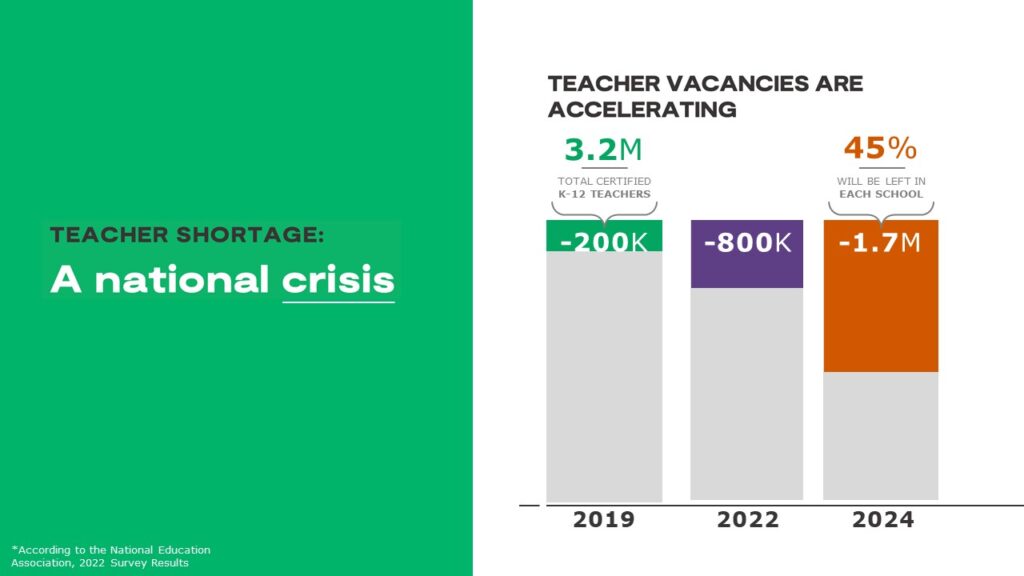
Additionally, colleges and universities are also reporting significant declines in enrollment, which also signals that this will be an ongoing problem that requires creativity, innovation; in order to ensure that our kids receive the quality education they deserve, irrespective of the zip code that they live in. And so this is a big, very complicated process or problem with no clear definitive solutions. We’re here to potentially show you an alternative. And, so, as I’m sure many of you are aware, it’s not just like, “hey, we’re kind of short on science teachers across the country,” it is across almost every single subject across every discipline from kindergarten through 12th grade. Additional NEA, you know, resources and studies demonstrate that the current teacher shortage is affecting special education, math and science at a higher rate than many other subjects. And those are mission critical for the overall success of our kiddos. Hey, Kim, we can’t hear you.
Kim Kays 05:54
Yep, have to unmute myself. Before we get into the solutions, we want to see what you guys are doing out there, to solve this problem. We know there’s lots of folks doing innovative creative things, thinking outside the box. A few common ones are listed here. So, we’re going to kind of pull you to see where folks land out in this presentation attendees to see what you’re doing already, so we can kind of chat through some of those options and alternatives for those options if they’re not quite working. So, here’s another poll, which one of these are you doing? You can select any that apply. Non-certified teachers, emergency certs, J-1 visa, offering asynchronous options, combining classrooms, or other. And, if you do other, feel free to put in the chat what that other thing is as well. Feel like we almost need like some poll taking music as we wait. So let us know- I see a few submissions rolling in; let us know what you’re currently doing to solve your teacher shortage. See a few responses, wait for a few more to roll in. All right, we will close it in three, two, and one. Okay, so it looks like non-certified teachers is one of the prevalent things, that’s not a surprise to us. That’s what we’ve been hearing and a lot of our conversations across the country as well. Emergency certification and J-1 visas and combining classes. Those are definitely things that we’re hearing, for sure. Oh, I see some other things too, like lots of social media and website advertising. So, new ways to approach hiring teachers that schools have never had to do before. So, that is definitely something that we’re hearing as well. So, let’s chat about some alternatives.
Jenn Russart 07:53
Yep. So, in response to what you all shared, it is obviously, especially right now, schools and administrators are working tirelessly to solve this vacancy reality. So, we’ve outlined some of the options here. And, so, what we’d like to do is kick it over to Kakela, Dr. Robinson, who has experimented with many of these things throughout her career, and many of these different strategies, so, can you share with us your point of view on each of these buckets and each of these strategies?
How Schools are Addressing The Problem
Dr. Kakela O’Banner Robinson 08:26
Hi, thanks, Jenn. So, first, before I begin, I just want to it’s the end of the year. So, everybody on this call, I just want to thank you. You do a job that often goes unnoticed. And, probably at the end of the year, especially people in high school positions, you’ve probably had some tough conversations, heard some not-so-Sunday-school words in the last week as you’ve dealt with parents. So, I just want to thank you. And let you know that your job does not go unnoticed, and that we understand those struggles that you go through daily, just to make sure that a child receives a quality education, and I appreciate that.
Non-Certified Teachers
But, I have also been in your shoes. And I have tried every single thing on this list, including probably 10 other things, just to make sure that there’s a certified, or a not only certified, but a highly qualified teacher in the classroom. And I saw from the poll, that you’re doing the same thing. So, just starting with non-certified teachers, and that was where a bulk of mine came from. Either they were not certified for that subject, or they were not even certified to be a teacher at all. And if they’re not certified, they’ve had no experience, then of course they don’t possess the qualities, the background knowledge they need to be in the classroom to provide that education for our students. They also don’t have the background of how to do classroom management, how to deal with parents, how to build relationships with your students. They’re really just being sometimes a warm body. You will find some great success stories. But, probably with every great success story, there’s also some horror stories that go along with that.
Emergency-Certified Teachers
Um, emergency certified teachers, I’ve done that as well. One drawback from that, of course, is that there is that lack of experience. Another drawback from that is who’s going to foot the bill for that. Most of the time, especially in the state of South Carolina, if you do emergency certification, if the teacher is going to remain, they have to add sort of that certification. That’s gonna mean practice exams, that’s going to mean additional work from the university level. And courses aren’t cheap. It’s like $600 a course at most of our universities. And they would most of the time need at least three courses, plus the practices, to add that certification to their certificate.
Combining Classrooms
Combining classrooms, that was always the worst thing for an assistant principal to have to deal with. A class of 15 is now doubled to 30. You’ve got two subjects in the room, behavior problems, discipline problems. And the worst thing that you can ever start a conversation with a parent about when you’re disciplining a child, or something that’s happened is, well, they weren’t supposed to be in that room anyway. But we had to put them in there. It’s just a no win for the district, the child, or the parent when you have to start a conversation off like that.
J-1 Visa Teachers
J-1 Visa teachers. Same thing, I have success stories. But I’ve also got a lot of stories where it just didn’t work out for our district. Also, with our J-1 visa teachers, there was a huge culture barrier that we had to get around a lot of times, there was a language barrier sometimes that we had to get across. And also the paperwork that’s involved with J-1 visa teachers, when we first started with it, we didn’t understand, especially when we started to possibly consider sponsorship, that that would really become a full-time job for someone. Getting attorneys involved; advertising the position, you have to keep up with how much your advertisement budget is, for those teachers. Those are things we didn’t know. And as HR, I focus on finding teachers not sitting there doing administration for international teachers, but it became that some in some cases. But, all of these alternatives, what I just overall felt they did was they drew your attention away from going in a classroom every day and providing quality instruction. You were burnt out, you were taken on more than you were supposed to, and losing focus of day-to-day providing the best education for each student.
The Impact of Teacher Burnout on Education
Jenn Russart 12:59
So, Dr. Robinson, what I’m also hearing is, in addition to the teacher shortage, we’re also now starting to see a lot of principals and assistant principals also leaving the profession. So, do you think all of this additional burden at the school level that’s put in terms of managing some of these strategies could contribute? And what are your thoughts on that?
Dr. Kakela O’Banner Robinson 13:21
Absolutely. My mother is an educator, she’s a principal, my husband is a principal and I wake up many mornings now with that’s how they’re starting their day, because their phones are ringing and it’s “somebody’s not coming to work, and we’ve got to get this covered”, or “I just lost the teacher.” How do we pivot? And it’s 6 am. And your kids would be in the building by 7:30 am. It’s just a lot of burnout on both levels. How do you, especially when you have honors classes, or people are going to take AP exams, and you lose the teacher. That gets board members involved when you have discussions like that. And sometimes it’s from no fault, even with just burnout; people move. Teachers just leave. And in the middle of the year is hard to find a teacher. So, I just spoke to a superintendent today. It’s June but if you haven’t filled that vacancy now, with our schools going back for first week in August, it’s very unlikely that you’re going to find a qualified candidate. So, already you’re shifting your mindset onto what am I gonna do versus just trying to find someone because you know, no one’s out there. You’re now thinking how do I make this work?
Jenn Russart 14:45
Yeah, and I think what we’re starting to see, particularly in like this post-COVID, post-pandemic world is that kids are in a different headspace. and that we have absolute learning gaps from the two years of chaos that we’ve all lived through. And, so, what we’re seeing is these current solutions and these current band-aids that we’re all using to address this one problem can provide that short-term relief, but then also has some long-term consequences, what are some of the things that, you know, you can point to, Dr. Robinson, that, you know, as this has continued to progress, where are our students needing the most support?
Dr. Kakela O’Banner Robinson 15:24
Relationships? Definitely, COVID made us realize we had to think differently. There’s no turning back the clock now, we can’t go back to what was pre-COVID. That’s not going to happen. Our students aren’t going to let that happen. They were changing. I think education didn’t want to change. But COVID is now making us change, the adults change. Our workforce is saying, “we need to do things a little bit different.” There was a time when we would say, “you cannot work from home.” Well, COVID showed us yes, you can do that you can teach differently, you can do things a little bit differently now. Technology, I think you have to have that in your budget, you have to be forward thinking with your technology, your infrastructure in your district, because that is just part of education now. Years ago, that used to be a sad item, something you would consider on the back burner. No longer, it’s right in the forefront. How are you going to replenish your laptops? How are you going to increase your bandwidth in your building? Those are conversations you got to have upfront. Not later, but now, as you’re building your budgets each year. But, also, just because the kids are behind, COVID did create a gap. How do we continue to teach what we need to teach, but also make up that area, because we can’t go we can’t go back two years, because then they’ll never catch up. So, we have to find a way to meet them where they’re at, take them to where they’re supposed to be, but also cover all of this in between at the same time.
Addressing the Challenges of Teacher Shortages through LIVE Virtual Teaching
Kim Kays 17:13
I think that’s the perfect segway to get into how we can start to think differently about this, right? There’s lots of things that we’ve done in the past, that, kind of, some people are stuck spinning their wheels, and all of these older solutions. So, I think really like forcing ourselves to think outside the box and think differently is what we’re here to talk about. And I think what we love at Elevates, and what we believe in, is that live teaching really can still be possible in a new and different way to really build those relationships, meet the needs, fill those learning gaps. And, so, what you can still accomplish with live teaching is getting quality teachers using that impactful, impactful curriculum, making sure you’re leveraging technology and that in-person support in a different way that’s outside of the box from some of those ineffective solutions before that we know can cause a lot of issues and problems so that you can still give students that experience they deserve and have them make those educational strides in this different way with live teaching.
High-Quality Teachers
What defines a high-quality teacher?
Jenn Russart 18:14
And, so, obviously, the critical component is that highly qualified and certified educator. And, so, this question I posed to Dr. Robinson, you know, what has changed in terms of how you evaluate the credentials of teachers that you’re potentially thinking about bringing into your district. So, what’s changed over the course of the last couple years?
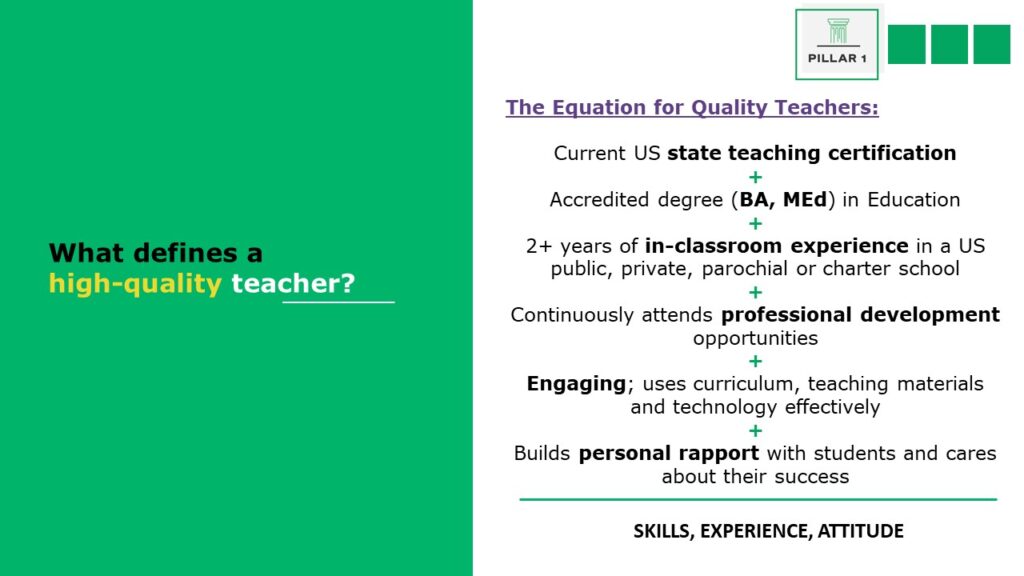
Dr. Kakela O’Banner Robinson 18:41
Definitely, for me, and I think for every colleague that I’ve spoken with in the last couple of weeks, is just the number of applicants. There was a time in my former district where I’m actually from, where I went to school, where you couldn’t get a job in our district. It was not happening, you would have to go to a neighboring district and get years of experience and just pray to one day be able to get into our system. Those days are gone. I was at an awards day program just yesterday. And, as they were saying the majors of every child out of possibly 50 students, I may have heard one was major in education. And it broke my heart to hear that. They were all they were all going to prestigious universities. But none of them are going to plan to major in education. So the pool is definitely different.
Declining Enrollment
Kim Kays 19:41
This might be a good time. There’s actually a question in the chat that saying like, we know enrollment is declining across the country. So, will that eventually balance this teacher shortage need or will we still see a teacher shortage need? So, I wonder if you can kind of talk to that Dr. Kakela about like, declining enrollment, is that Is it declining enough to offset the demand of teachers? Or where do you see that going in the future?
Dr. Kakela O’Banner Robinson 20:06
No, I don’t see a decline in the number of students enrolling. So, when you say that, I think they’re seeing a lot of decline in rural districts. But even if you only have 10 students, you still gotta teach those 10 students, but those students that moved are just going to another district. So, then, that district is going to experience our shortage and teachers. So, I was saying the district that I’m originally from, they are seeing a decline. But, then, when I talk to the neighbor and district, they’re saying they’re busting at the seams and about to pull in portables, because they’re just jumping the line, and they now need teachers. And those teachers just are not there. And if they are there, they’re not bringing the same skill set that you would think a first-year teacher would bring from the university. There’s a lot of gaps. And we have to think, even with COVID, they lost time that they were preparing to go into education, they didn’t get to go into school and do their practicum and spend time with children and spent hours in town with a mentor. We did things differently for two to three years. And we now have to go back and undo some of those things.
Evaluating Teacher Candidates
Jenn Russart 21:24
And, when you’re evaluating candidates, what are some of the key things that you look for when you’re thinking about- y [ es, this is, like- what are the key things that actually gets you excited about that teacher that’s applying to your district, versus what I’m hearing from so many partners as like, “it’ll do?” Or “they’ll do.” “They’re okay.”
Dr. Kakela O’Banner Robinson 21:44
Yeah. So, so often now, I hate this term, I hate to even think that this is what we’re doing, but they’re like, if they have a warm body, and they’re breathing, they’re going to hire them. And that’s sad. That sad, that’s what I think is happening. A lot of times it’s we got to applicant, we got to feel it, we got a warm body in the classroom. I remember before I had a principal, she would not hire an applicant until she actually had a chance to see them teach, she would either require them to come into her building to teach or she would take the time and go into their classroom or whatever district to see them teach. Even if it was virtually, she was going to see them teach. Even she has had to come from that now. Because she’s got to fill a position. I would I want to say an applicant is one, the love of teaching. We have lost the love of education, the love of teaching, I want to see that an applicant. I want someone even if they are not the best. And that’s another thing I think we’re gonna get to later on of how Elevate can help, that you may not have at all, but I can help you get there. The willingness to grow is what I want to see in a teacher, that if you if you meet me here, I can take you there.
Professional Development for Teachers
Jenn Russart 23:01
Yeah. And, so, ultimately, right, also, when we think about the ways that everybody is scrambling to address the gaps in the classroom, it is putting more pressure on the teachers and the staff that are high quality that you want to be able to retain, right. So, Dr. Robinson talked about earlier, class sizes were 15. Now they’re 30. That’s twice, you know, the amount of work. And, so, when you have twice the amount of workload, it’s a recipe for burnout and exhaustion, which again, starts this whole cycle all over again. So, what are some of the ways, even from like a professional development perspective, or, Dr. Robinson, what are some of the things that you did to support some of the some of the teachers that you had under your purview?
Dr. Kakela O’Banner Robinson 23:47
One thing that we were big into, we were very big in PD, but also building a time in our schedule for PD. The worst thing you can do is have a teacher teach their heart out all day long. And then make her stay after school, or he stay after school, an hour or two hours, for professional development. And then they have to go home and grade papers, do lesson plans and get their own family together just to repeat it the next day. So, we did put a lot of support into the day with professional learning communities will enter their schedules. But, even that is a lot; teaching is hard. It is not a come to work, just sit down. No engagement. It is constant, constant constant interaction. So, it can wear someone out. So, if you don’t have that support, which a lot of teachers feel they don’t have their silos, especially in high schools. They feel like they get a book and a set of keys and four walls, and they’re just left to figure it out. And then testing, you know, you try your hardest. That’s the worst thing that can ever happen to a teacher is you give them children who are two or three years behind, they teach all year long. And then when test scores come out, you don’t get the results that the public or some other stakeholder wants, but you know, that child grew. But that’s not the number that is shown because people only see the number, they don’t hear the story behind it. So standardized test sometimes just kill us in education, because it doesn’t tell the whole story.
Emergency Certifications
Jenn Russart 25:26
Oh, absolutely. And then one final question on this topic that I had for you. Going back to something that you had mentioned earlier, when we were talking about emergency certifications, where you those teachers know, like, they’ve got some level of subject matter expertise, but not necessarily in the course that they are teaching. What is the impact on some of the other teachers in that department that have more experience when you know, when that, when that strategy is utilized at it at a school.
Dr. Kakela O’Banner Robinson 25:53
It creates morale issues in the building itself, it’s unfair scheduling, they feel you gave somebody, that’s your favorite, why did my schedule have to change? Sometimes you have to use a PE teacher to teach art, that’s not a good situation. Sometimes, in the end, no one likes change. But, as an administrator, you have to make decisions just for the children. But, in the end of the day, it hurts everyone, because it pulls and drains so many people, and putting them in positions that they’re just not comfortable in. They have a skill set that they’re familiar with, with their subject. But, then, you’re asking them to teach and learn something that they’re just not ready to do or have the time to do it. So, then, they lose that passion. And they can’t be great at what they’re great at, because they’re trying to cover so much.
Using Curriculum to Improve Student Outcomes
Jenn Russart 26:50
Yeah. Thank you so much. And then pillar two, so, an impactful curriculum. So, so many all, of you on this call, have spent a ton of time trying to identify what are the right resources for your kids. And, so, obviously, it’s paramount to any educator. Dr. Robinson, what are some of the areas that you’ve used curriculum or different curriculum resources to drive and improve student outcomes.
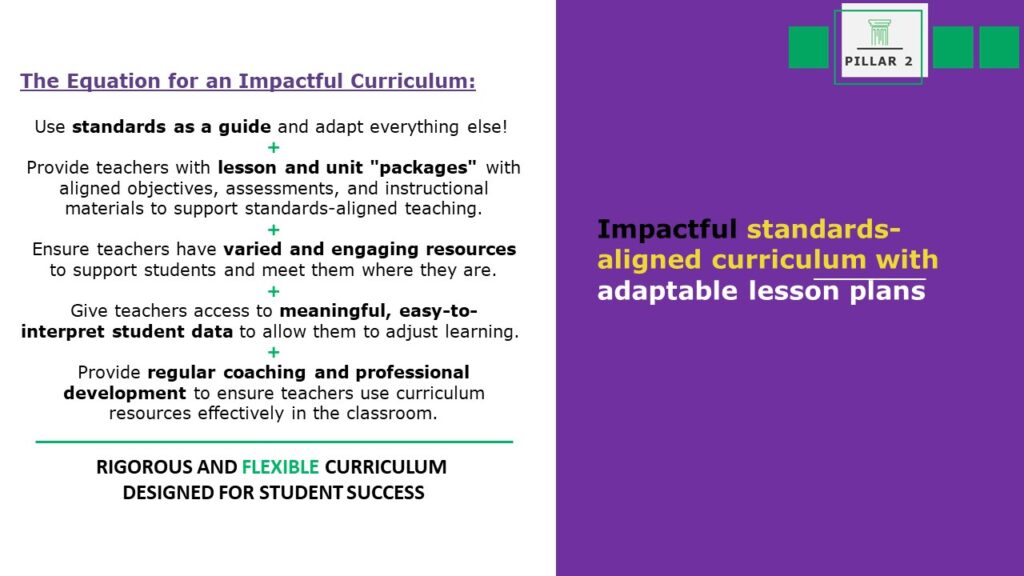
Dr. Kakela O’Banner Robinson 27:21
So, every time I’ve been in a district, we focus a lot on curriculum, and it is labor intensive. First, it’s one, dissecting it to make sure that is appropriate and make sure it aligns. And then also building common assessments that you use across different grades, different subjects, and, of course, throughout the district. But it takes time, it also takes time, it takes time, one, to develop it, it takes time to do the professional development to make sure that everybody understands it. Also then gathering the data to make sure, or see what you have to do differently, because maybe they’re not getting it like you thought they were. So, curriculum. The biggest issue I saw in some districts, especially with mine, I had rural districts was having the capacity to just be able to build that curriculum. Or, you would have to go to the outside and get it, train someone in district or bring someone from outside to train, and then share it along in the district. Also, in rural districts, and now many other districts, you have a lot of change in leadership. So, that curriculum often changes and teachers would love to say, what’s the new program? Every year they get a new program, just hold on that program will be gone tomorrow, I don’t really have to invest in it because that program will be gone. And so that builds into that burnout, that frustration, is constant change in education.
Jenn Russart 28:56
Well, that ,and then how do you how do you measure and ensure that the standards are being taught in the same way at the same time, especially when you have all of these different resources and then all these teachers that are coming from everywhere? How do you manage that?
Dr. Kakela O’Banner Robinson 29:12
So, what you end up doing is you end up employing more people to manage that. And then you bring on instructional coaches. So, you bring on reading coaches, you bring in district level people to make sure that that’s all being done. You’re constantly hiring more personnel to do exactly what you just said, to make sure that what you just purchased is getting done.
Jenn Russart 29:39
And everyday, too. Yes, Every day, every lesson. Yeah, so obviously, you know, no easy feat either for for anyone.
Dr. Kakela O’Banner Robinson 29:50
Yeah. And you’re doing benchmarks, you’re doing common assessments. You’re meeting in PLCs to share the data to see if they’re meeting standards before the big test.
Using Technology to Improve Student Engagement
Jenn Russart 30:03
Oh, absolutely. And we touched on this a little bit. But, obviously, finding a way to prioritize that integration of technology and different modalities of learning and different ways to keep students engaged in the curriculum and in the instruction is paramount, because kids today learn differently than than we did, you know, at very early ages, they’re teaching themselves how to do things on YouTube. I can barely get YouTube to work on my TV. So, we’re dealing with a totally different type of learner than, you know, what we’ve been accustomed to, particularly if we think about children that are in third grade now, during COVID. That was their first exposure to school. So, they grew up learning behind the screen. And, so when we’re thinking about technology, Dr. Robinson, you talked about prioritization from a budget perspective; can you talk a little bit more about how teachers and teaching can also leverage some of the tools available in technology?
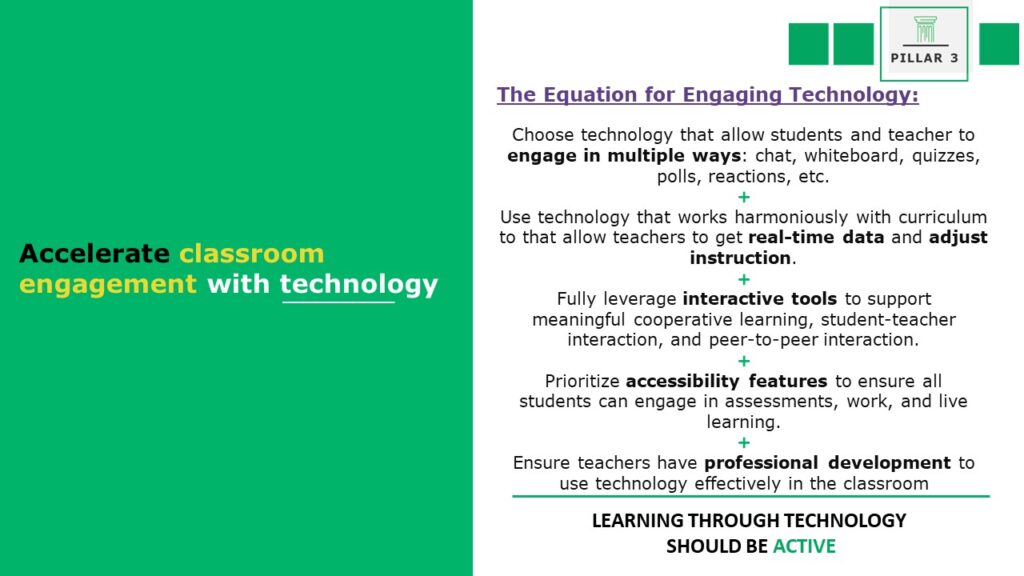
Dr. Kakela O’Banner Robinson 31:03
Yes, so, I always say that kids will learn on a doubt. When we hit COVID, it wasn’t the kids who had to learn how to adapt and make it; it was my teachers, and my administrators who had to accept, “we’re going to have to use these devices, and they’re going to have to come out the closet, we got to use it. And we got to make it work for the kids.” And I think a band class that I just saw perform was a perfect example of, they learn how to start playing two years ago over the internet. And now they’re winning awards three years later, because it was possible. But, it takes a different mind shift in administration and with a teacher to say, “how do we use this device as a tool to do what we know how to do.” All this laptop is is a device, you still have to teach. And I think that’s what Elevate does well, it allows a platform for sound instruction to still occur, but to be able to get it to zip codes who are struggling. So, my engagement with technology from the district level was one, providing them a device that was appropriate. Because there are several devices, you have to find a device that fits for your students, for your bandwidth, and for your needs of your students. You have to make sure that you have a plan in place. So, how are you going to replace those devices. You have to have the support staff on staff that can troubleshoot because you are going to have issues; building that into it. Professional Development for your teachers, making sure that they’re comfortable so that they can focus on instruction, not on the device.
Giving Teachers In-Room Support
Jenn Russart 32:54
Yeah, absolutely. And, so, the last pillar that we have is in-classroom support. And, so, when we envisioned the Elevate platform many, many years ago in a pre-COVID world, right, I think we somewhat ended up limiting ourselves in terms of what that role could look like. So, we typically would talk about it in a paraprofessional capacity. And what we’ve learned and what we’ve seen is so many of our partners, through the years, thinking more creatively about what this role could do from a professional development perspective, particularly with teachers that might have an emergency certification, right, where you can ensure that you’ve got that high-quality instruction with, you know, that person taking a supporting role, but then learning how to manage the classroom and ensuring that the, the instruction of that content is landed. We’ve seen our partners leverage that role for the J-1 visas that are coming across for that first semester. So, they can just focus on that acclamation, and let the instruction be delivered by a high-quality instructor in a modality that allows our teacher to be able to differentiate and meet the kids where they are. And, so, we’re seeing this more as a professional development sort of a role instead of just hey, you know, let’s- as a babysitter, I’ve heard one of our partners refer to it as, “I don’t want a synchronous instruction, even when it’s alive. When you’ve got like live teaching, what I’m looking for is a synchronous experience.” And that’s really in tandem with the classroom coach and the instructor working together to ensure that those kids are learning and that we’re also meeting them where they are on their educational journey. So, Dr. Robinson, how have you experienced you know, how the Elevate instructor and that in-person support are able to work together and collaborate to create an engaging classroom experience for our students?
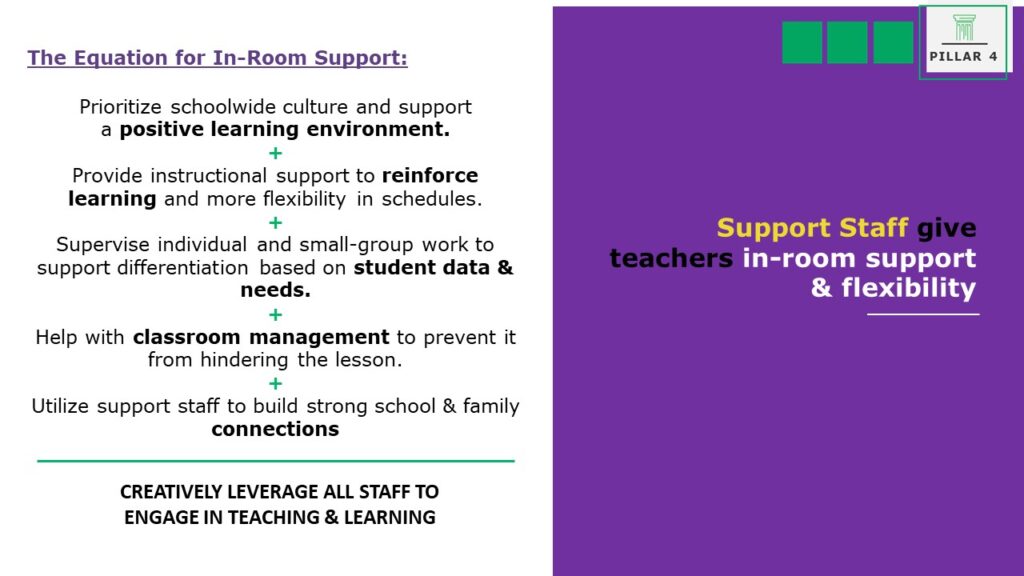
Dr. Kakela O’Banner Robinson 34:51
So, I had a perfect example happened for me in Marlboro County School District, where the classroom coach and the Elevate teacher, they built a relationship to where you would not know that they were not talking and seeing each other every day. They spoke each other’s language, he knew what her next word was going to be, you could tell that they were carefully planning together. That they were meshing; it reminded me of a kindergarten classroom, where you have the ParaPRO and the teacher there, where you can’t, when you walk in, you don’t know who is who. That’s a perfect world. And you mentioned something earlier about being very creative. In most districts, school boards will love to say, grow your own programs, grow your own initiatives, because they want teachers, they want people to come back to their neighbors, their neighborhoods. And, sometimes, that’s hard. But, I found that Elevate allowed you to do that. It allowed you to have a certified teacher, but, as a classroom coach, have someone who’s interested, possibly could become a certified teacher. But instead of having to focus on curriculum and classroom management, and deciding if education for was for them; they were able to just concentrate on classroom management, learning about the inner workings of a school day, and pick up from the teacher, how to do the curriculum, so that they could decide if that’s something they wanted to actually do. And it could be for the first semester, if it was a teacher that was coming in late, or let’s say, an international teacher, because one thing that you have to be careful with the International Teacher is, visas don’t care when your first day of school is. They’re gonna get there when they get there. So your school may start August 1, but the teacher may not show up until November. So, you have to have a plan for that. But if you have that setup for the J-1 teacher to go with, that allows them to create a relationship, because that is so important in the classroom. So that J-1 teacher has a chance to create a relationship with their students, while they’re getting instruction from the teacher from Elevate; second semester can go a lot smoother with those students.
Jenn Russart 37:18
Yeah, it’s interesting for us because we always feel like “oh, we can’t build those relationships online.” And you absolutely can. We have stories from one of our district partners in Georgia, where we cover Spanish one, and then they have an in person, Spanish teacher for Spanish two, second semester. But when second semester hit, those kids would go back and say hi to our teacher that was doing Spanish one for that next group of kids. We’ve got stories of teachers meeting kids in person when they’re traveling in the same area. And, so, it absolutely is possible to still create that relationship. And a lot of that is due to the involvement and the active role that the classroom coach plays in communicating what’s happening at the school with our instructor, so that so that they want to participate, too. And, so, there’s just there’s so much value that can be derived from having that close aligned relationship. And, so, we can move on to the next one. And, so, ultimately, there is no magic bullet, there is no one thing that anyone can do to ensure that you’ve got the right people in front of kids at the right time.
The Four Pillars of Elevate K-12: A Transformative Approach to LIVE Teaching
What we at Elevate strive to provide is another option and another alternative to ensure that we’re focusing on the right outcomes for your students. Because we believe that there is so much value that occurs in that traditional classroom environment where our sole focus is to ensure that, across the country, kids have access to high-quality instruction, and the opportunity to learn amongst their peers. So, in light of everything that’s happening, on the other side, our teachers are looking for flexibility, they’re looking for the opportunity to be able to work four hours a day from their home, but then still be able to get that experience of that love of teaching that Dr. Robinson hires for. And, so, Elevate provides the opportunity for us to get those high-quality instructors in front of students that might not see a teacher of that caliber, to hopefully reignite that engagement and the whole learning and educational experience. And, so, the students, and our teachers are at the heart of absolutely everything that we do as we continue to move forward. So, one might say, “how does live teaching work?” So, I’ve got a little video for you. Or not. So, you’ll be able to click through the video when we share the slide. So, this is actually a shot of a classroom in Colorado. And, so, we always like to share this because this is what Elevate looks like in real life.
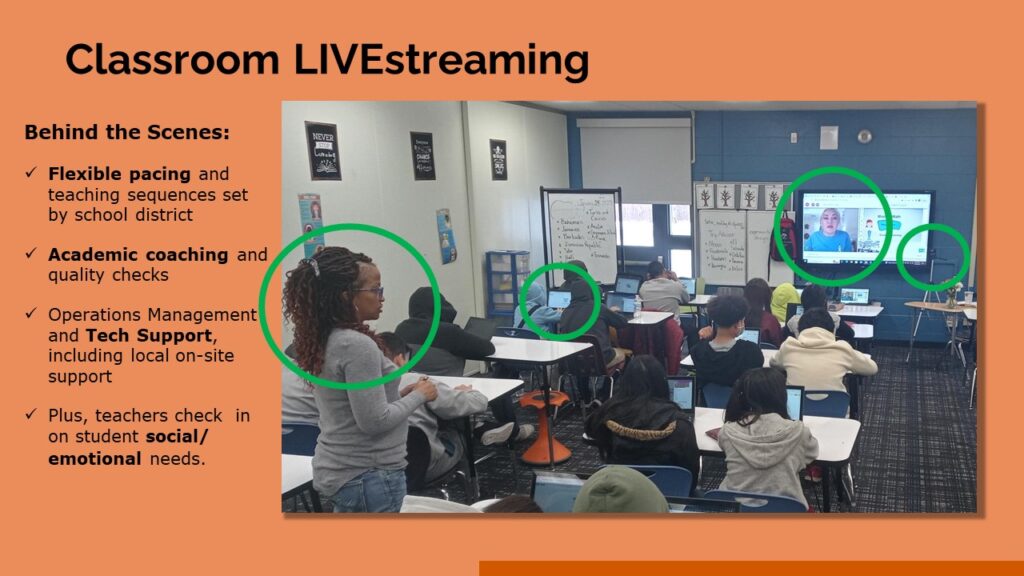
So you can see in the corner, you’ve got the camera, our teacher is on the screen, this is the classroom coach. And the cool thing about how this works is Dr. Robinson has made two or three comments about bandwidth. So, what we’ve done is we’ve designed our platform specifically with K-12 in mind. And, so, the reason we don’t have those cameras enabled at the device level is because it crushes the bandwidth at your schools. And, so, the teacher has a wide pan view of everything that’s happening in the classroom. I visited many where we’re observing classrooms, and the teacher will hear whispers happening in the in the back end corner of the room, and she’ll call those students by name and you know, hold people accountable. But, they’re seeing that the teacher on the front with a lesson, and then they’re only seeing the lesson on their one-to-one Chromebooks, laptops, etc.
LIVE Teachers
And, so, it’s very much the way that a typical classroom would be designed, except the teacher is delivering that instruction from the screen versus, you know, being in person with those kids. And, so, one thing that we really want to highlight here are those things, those two things that Dr. Robinson is looking, for that love of teaching, and then obviously the subject matter expertise, and that’s what we are doing. And then, at through our interview process, we are actually evaluating their ability to be able to present a lesson in this modality. And, so, we’re not only looking for highly qualified, you know, the right certifications, but then also do they have the ability to make this medium, and this modality, exciting for kids. And, so, that’s one of the things that we’ve heavily indexed on as we’re going through our recruitment process with our teachers.
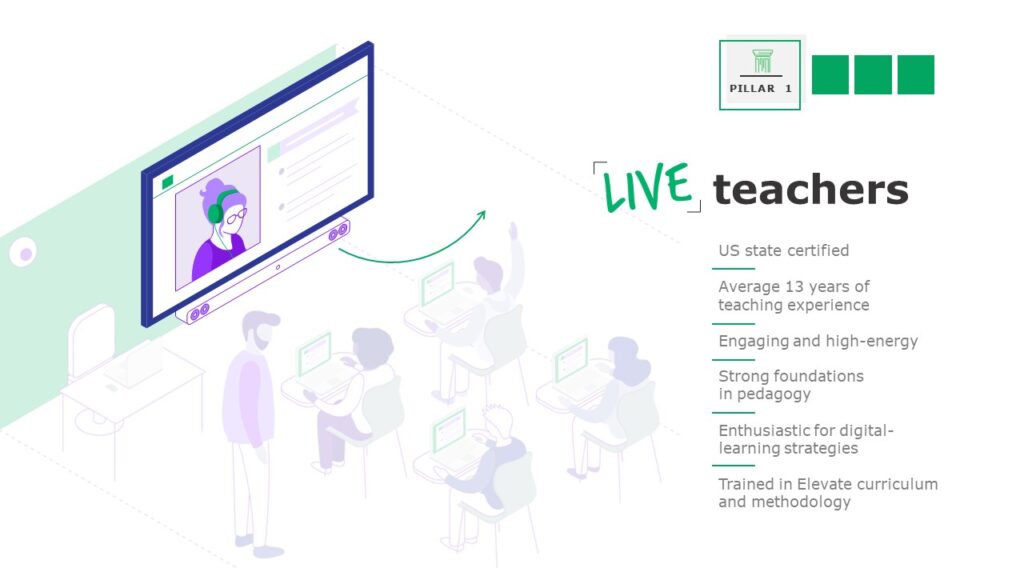
Impactful Curriculum
And, so, the second pillar is that impactful curriculum. So, when we’re talking about consistency of delivery, that’s what we’re able to ensure. All of our teachers are trained on our curriculum, but what we can do is we can map or match our scope and sequence to what’s being taught in the traditional classroom. So, there’s parity and what kids are learning where, and then each of our curriculums is also designed to the state standards of states across the US.
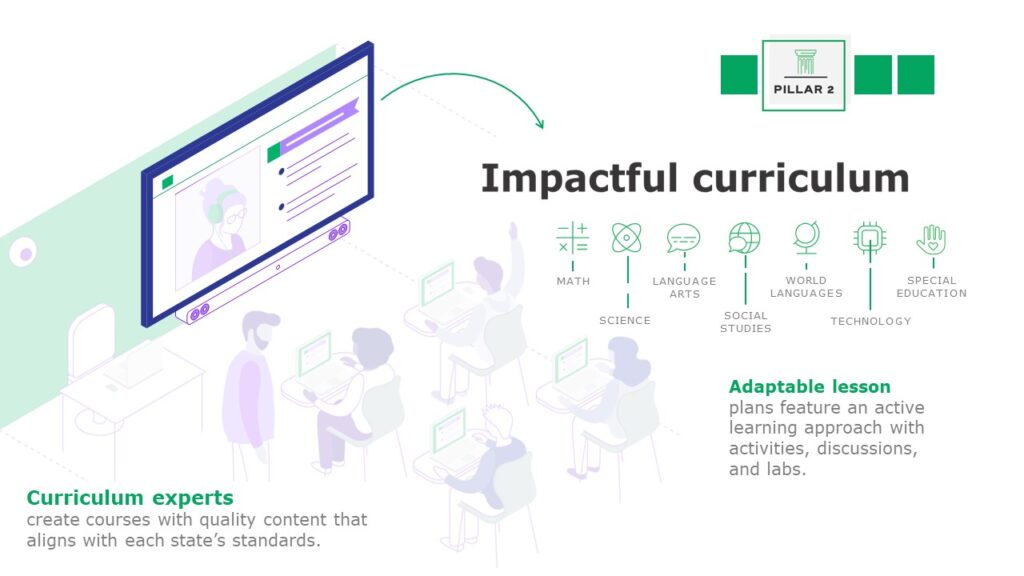
Learning Technologies
So, on pillar three, technology, everyone’s favorite topic, mine included. So, our platform is designed specifically for K-12. So, it’s our proprietary technology that really uses tools like social-emotional polling, cue z’s, because we’re super clever at Elevate, which are our formative assessments, which allow our instructor to be able to differentiate in real time on ultimately meet students where they are. And, so the fourth piece, we spent a fair amount of time on this, but that in-classroom support, so that classroom coach plays an integral role in the performance of the students, and the overall classroom experience.
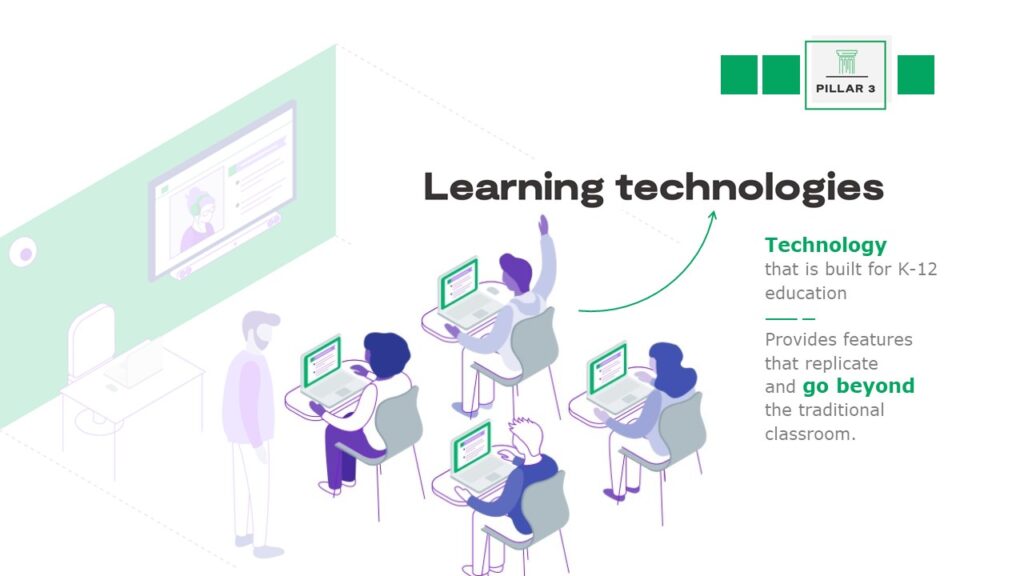
In-person Support
And, so, we provide that classroom coach training. So, when you’re thinking about professional development opportunities for some of your newer teachers, or maybe some long-term subs that have an interest, potentially, in going into teaching, or where you’ve had to leverage some emergency certifications, we provide additional classroom management training to those individuals so that. hopefully, this is a good training ground for that grow your own, without providing additional, you know, additional things for your existing staff to have to do.
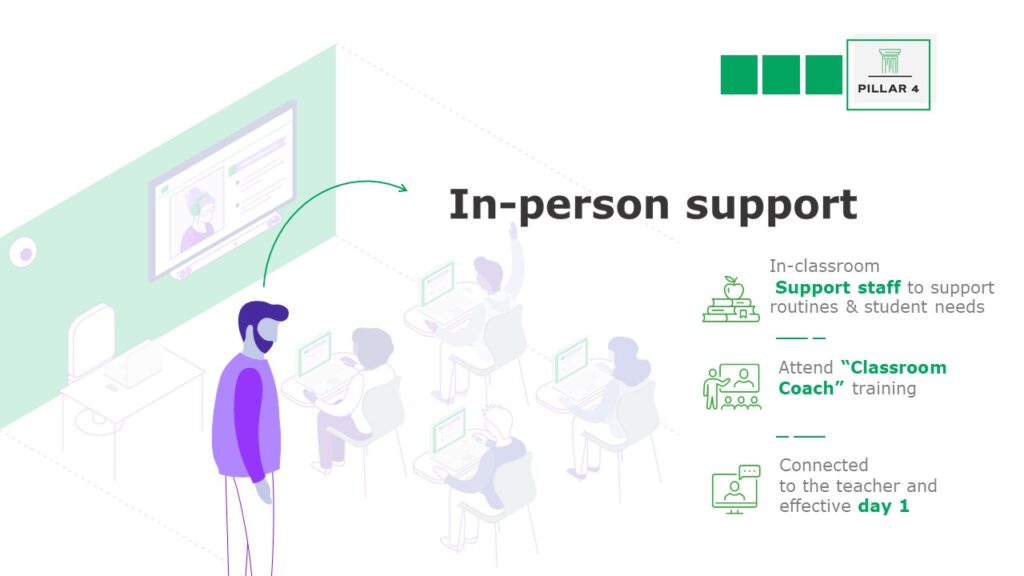
And, so, one might say like, “Hey, what does that mean? What happens if I partner with Elevate?” And, so, overall, we’ve seen a 73% increase in benchmark assessments through students that utilize our platform. 88% of our students find Elevate classes engaging. And this is the one that I really want to highlight, is 95% of our students rate elevate teachers are supportive, and know that they care about them. And that’s the piece that we want to highlight. Because that’s the one question that we get all the time is. “how are they able to build relationships?” And it’s absolutely possible because when we’re onboarding teachers, we’re looking for people that a. love teaching, and a part of loving teaching as loving kids, but then also are able to connect in the space that we’re in.
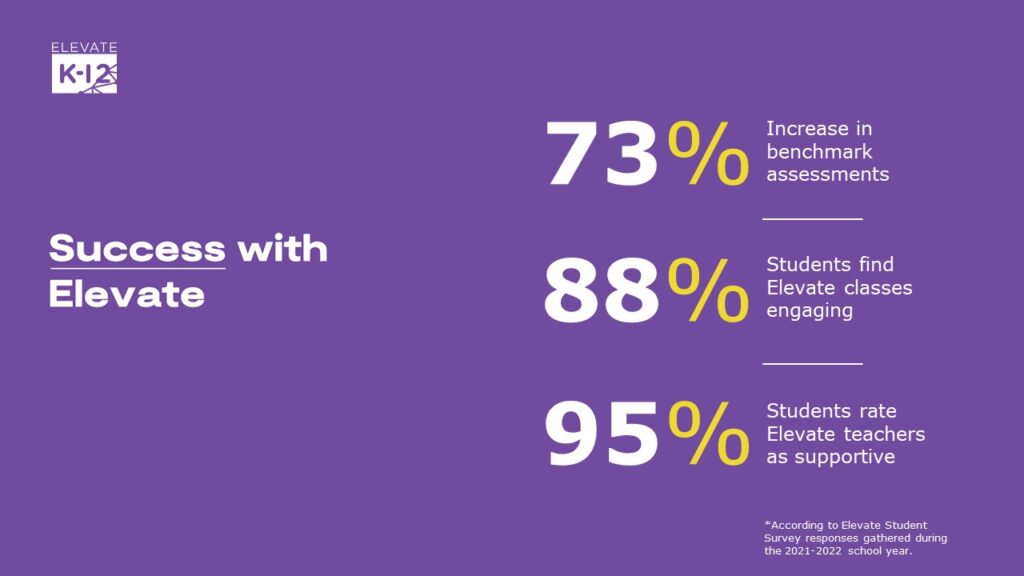
Dr. Kakela O’Banner Robinson 44:52
And, Jenn, if I could just say, one thing about your curriculum when you said how do you know you’re successful? A lot of times districts, some may not have those benchmarks in place to where they’re monitoring what’s being done. Elevate has that, where you’re going to monitor, are the children getting what you wanted them to know. And in small districts, such as the one I was in, all of our teachers didn’t have access to that. But that platform that you provide, provides that for them. And I will just share with everyone on this call, it’s not an easy decision, you’re not going to get everyone to agree to it. But when you see the numbers, and the rigor that Elevate can bring to your curriculum, I think you’ll see it in your test results, because we saw it in ours, our Elevate classroom had the highest EOC scores, to where our principal had to say, I need to know what that teacher is doing that mine aren’t.
How to Fund LIVE Teaching
Jenn Russart 45:57
Yeah. So, one question that we get quite a lot. So, we wanted to spend a few minutes here is, “hey, this all sounds great. How do I actually pay for this?” So, the way that our programs are developed is, it’s meant to be modular. So if you want, especially for like our rural partners, or districts where they have some schools that have really low enrollment, where you might not be able to offer that CTE class, or those advanced math classes, for a multitude of reasons; Elevate allows you to be able to pick and choose how you use us, versus if you wanted to bring CTE to a rural district, you got to find someone that’s going to that you’re going to pay to do basically one to two sections of CTE. So we’ve really developed this so that you can kind of play around with what subject areas and how you leverage the Elevate modality throughout your district. And, so, as we move to the next one, Dr. Robinson, what are some of the vehicles that you use? Many of our partners will use FTE funds. What are some of the ways that you’ve seen, or you have used yourself, Elevate from a funding source perspective?
Dr. Kakela O’Banner Robinson 47:06
So, when I first heard about Elevate, I originally wanted to use Elevate to bring courses or high school AP courses that we could not offer because we would only possibly have one or two students. So, I couldn’t justify a whole FTE on that. So, I’m like, “how am I going to pay for this?” And, at one of our middle schools, I wanted to offer sign language, other electives, Spanish, and I could not afford an FTE for that. So we’re going to use Title One money to pay for those positions, just pull up a small pocket of money out just to pay for that course. But then my positions weren’t filled. And I started brainstorming and saying, “Well, maybe you could cover this for me. This, they can see for me,” and so I had to go back to the drawing board. And I will be very upfront, I have had many discussions with our CFO, and we had to have some tough conversations. But we had to keep going back to, “we’ve got to do things differently. You’ve got to find a solution.” Because at the end of the day, what’s important is a qualified teacher being in front of the students. And what I would always ask my CFO is, “if we don’t pay for Elevate, are those kids going to come to school tomorrow?” And the answer would be yes. “Who’s going to be in front of them?” Either, it’s going to be a non-certified teacher that you’re going to pay the same salary, a certified teacher who’s not in his or her correct certification, but you’re still gonna pay him that same salary. Or you’re gonna pay a substitute. All that money, once we get in a room, and we all think together, can be shifted most times and pull from different pockets. But you have to be willing to just say, this is our end goal. We’re going to think of a way to do it differently. Because, either way, that child’s going to show up to school and you’re going to have to educate them. How are you going to educate them is the question.
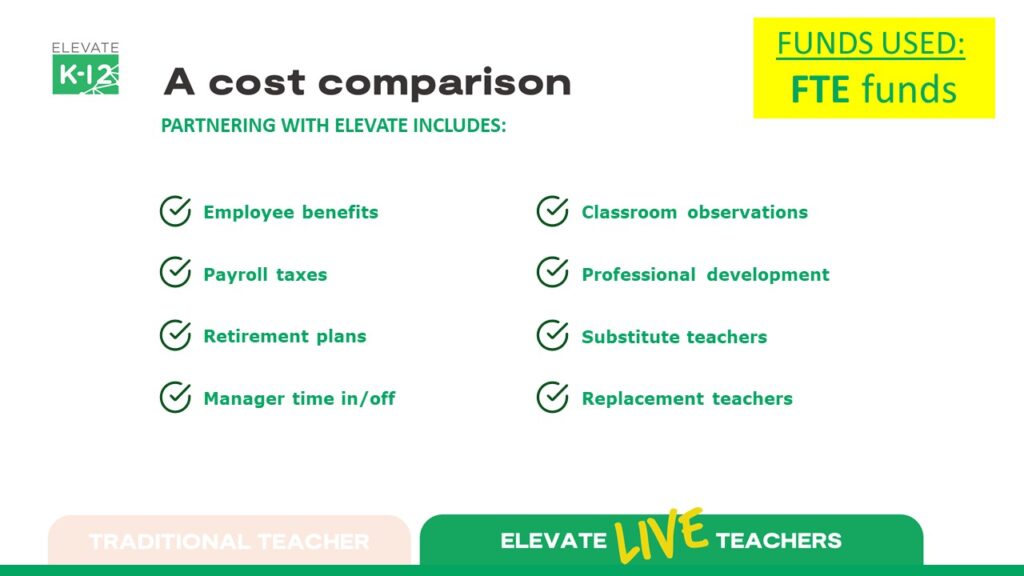
So we would pay, of course, we had SR funds. So that was you know, an easy fix, but that was sadly going away. But we pull from the general fund, we did pull from substitutes, you’re gonna have to have a substitute which is sometimes not budgeted. But you’re gonna go over in that fund a lot of times, and somehow it gets paid. So why not be proactive and say, I’m going to have to pay for it. And it’s just conversations you have to have with your CFO, also state. Now this is South Carolina. We already had our budget that we were going to have that teacher in the classroom. So we could adjust that FTE. Now we didn’t get reimbursed from the state fully for it all the time. But because it’s a certified teacher, we could put them at our power school and get credit for it. So, you just have to be creative, you have to go in the room with all parties at the table and say, “either way, we’re going to have to pay for this, where can we pull every pocket to pay from it,” but definitely look at your title one funds, any grant funding, local district level funds that may be reallocated. And we just pull from everywhere, because at the end of the day, our goal was to make sure a qualified teacher was in that position.
Jenn Russart 50:42
Yeah. And, even, one thing to add, too, is, and we didn’t talk about this earlier, surprisingly; but when we were thinking about meeting kids, they are there also, obviously, a bunch of our partners are using us for supplemental programming, either before school or after school, as well, when otherwise, like, if you don’t want to have your teachers stay, right, and add to that workload, it’s a great way to potentially, you know, leverage Elevate to help to drive towards those improved student outcomes. And then, obviously, again, you know, have another way to be able to pay for that, as well, including, like, you know, summer school, supplemental, etc. And, so, we’ll go back really quickly to how to get started with Elevate. The first would be to book a meeting, book a meeting after the end of this. And then we typically meet with your team, we understand where some of the gaps and then ultimately what are some of the educational objectives and outcomes that you’re looking for with your students. And then, where strategically does it make sense to have Elevate support, you know, those overall, those goals and objectives. So, we go through a discovery process and a scoping process to understand what those needs are. And then we also help you sell this to your board, right, because you do have to talk to your board, you have to talk to parents. And, so, we help navigate some of those tricky conversations with you along the way. The timing of this is perfect, right? Because everyone is about to hit the panic button, 95.5% of you on this call, join. Because you’re about to hit the panic button. And, so, from start to finish, the whole process from those initial conversations through implementation, take about four to six weeks. And, so, you know, the timing is right, based on when the first day of school is, to start thinking differently, start acting differently. So, I want to thank Dr. Robinson for facilitating and joining us from the conversation today. And, you know, just as a reminder, we have 1,000s upon 1,000s of students that are seeing outstanding results from using our platform.
Q&A
What are the strategies for hiring and retaining educators?
Kim Kays 52:53
Thank you so much. You too. I think there’s a couple questions in the chat that I think we can address in the next seven minutes. So, the first one is that hiring special ed teachers is a huge challenge right now. So, what are the strategies for hiring and retaining those educators? And how can maybe this solution meet that need?
Jenn Russart 53:14
Kim, you want to take this one?
Kim Kays 53:16
Yeah, I can take this one, actually. So, we all know that when it comes to special education, right, there’s a lot to do with federal regulation and requirements that are outlined in an IEP, there’s instructional minutes that have to be met. But, the way that schools meet those minutes, there is a little bit of flexibility there as long as you’re using certified teachers. So, what you can do is leverage the same kind of solution, right? It’s live instruction. It’s virtual, but it’s right there. It’s in small groups. So, teachers are building relationships with those students. I would say that we’ve implemented lots of really successful special ed programs this year, where at first the administrators were a little bit apprehensive of like, “oh, is this the right platform for these types of students? Are they going to learn best in this modality?” And we found the resounding answer is yes. Everywhere from younger students, to those older students and transitional programs, like, sometimes this more small group one on one virtual platform is their preferred way of learning, right? They’re safe to interact in that way, they’re building those relationships, they’re still able to get the content, they can have the pacing that they need and want and so, this is also a way where you can get those special education minutes met and those teachers in the door in that similar kind of block system that Jenn outlined, right, of where you actually only need these this many minutes of instruction per week, then we can find that certified teacher for you that will livestream in and solve that issue. And it’s been really, really successful in this modality. So, I would say we should definitely start to think outside the box in terms of how we’re serving our diverse learners and special education students, because many of them can really leverage technology and utilize it effectively to impact their learning.
What strategies can be used in teacher recruitment?
Um, another question in the chat is, what strategies can be used in recruitment to get teachers to come? So, maybe I’ll spend this question of like going back to thinking about, like, why are teachers burned out? And why aren’t they staying? And how do we get them to come in? And just thinking about that flexibility that Elevate is able to provide? So, maybe, Jenn or Dr. Robinson, if you want to talk about like, from a teacher’s perspective, what’s that outside-the-box flexibility that they’re getting from Elevate and teaching with us and going into a school than maybe recruitment from a traditional way of teaching.
Dr. Kakela O’Banner Robinson 55:36
So, one thing for us, because we use Elevate, we could then, in the building, make agreements with teachers where they could be part-time, which, before, we couldn’t do that. So if a teacher was willing to be part-time, let’s say in the morning, we could do that, and then fill the rest of the schedule with an Elevate schedule. So, that definitely worked for us. So, you got the best of both worlds. And that, just from recruitment, also, because you’re using Elevate for so many courses, then teachers didn’t have to teach three and four preps, they could only teach one prep, so we could offer them things that we couldn’t offer them before, a little bit of negotiation room in the conversations with teachers. And then also, I will say the grow your own is, are you willing to be the classroom coach first semester to see if second semester you would like to teach?
Jenn Russart 56:34
Yeah, and, on that point, too, we’ve also seen a couple of our partners, where it was used as a tool to reduce teacher workload. So, we had a rural district outside of Chicago, that one science teacher was teaching five different subjects every single day. And, so, what we did is, basically, we would do a co-teaching model where that teacher would be the classroom coach, but then Elevate would provide the curriculum, our Elevate teacher would do all of the grading. And, so, it can also be used as a way to reduce teacher workload, which, again, is another retention, you know, technique and a recruitment perspective, right? Like recruitment is one side, retention is the other. And, so, any opportunity where our partners are thinking about ways to use Elevate as a retention tool also reduces the pressure that you’re going to have to recruit later.
Does Elevate K-12 teaching work for elementary students?
Kim Kays 57:27
And I just saw a really great question come into the chat, does Elevate teaching work for elementary students too. And ,I can take this one as well. So as, as the academic Product Director, we just launched our third through fifth grade for math and ELA and our building social studies and science for semester two launch. And we were completely blown away and very happy with how third through fifth-grade students took to our platform; they were doing things we didn’t even expect them to do, like putting things in split screen so they can multitask. And, so, just like maybe Kakela was saying earlier, like, it’s really the adults who have this apprehension of, like, “Can kids learn this way? Can they do it?” And, so, yes, absolutely. Third, and fourth-graders thrive in this platform. They love the way that you can interact with the teacher through the private chat and the class chat and raising their hands and all the digital tools they can click on and learn through. And, so, yes, it works really well for elementary students. Right now we have more content from grades 3 through 12 available, and we’re building more elementary content in the next year. So, to make that more available, because we know like the secondary ed teacher shortage and middle school teacher shortage was a huge issue. But now we’re seeing that trickle down into elementary as well. More and more of those teachers are leaving the classroom too. So, yeah, we love to work with elementary schools. We only have about one more minute. So, I think that’s actually a good segway to go quickly, just through these slides, they’ll be in the presentation for you to go through. But, this is kind of the courses that are out there, how we can solve the problem for you and where you might see your shortages happening. So, this first one is the high school courses, we’ll just like breeze through them, and then you can look through them at your leisure. Here’s our middle school. And then here’s our elementary with some of our coming-soon for semester two ones as well. And, so, I think we’re at time, I think, Steven, are you going to pop back in?
Steven 59:26
Yep, back in here. Perfect. Yeah, if there any questions that weren’t answered, no worries, we at DA will be sharing them with Elevate K-12. So, they can answer your questions after the webinar. And, actually, as I go through my closing slides in just a few minutes, you know, please feel free to continue submitting your questions, if any come to mind and I’ll make sure they’re sent over to Elevate K-12 so they can be answered at some point, as well. And also, feel free, and I’m going to pop it right up as well, feel free to click or download the assets in the related content module. If you don’t want to wait for the email tomorrow with the presentation slides that are in there, as well as the YouTube video that was mentioned earlier. So, they’re all right there, you can download them safely and easily right now. But, first off, thank you again to Kakela, Kim and Jenn, for you know, for sharing your expertise and time with us today. We really appreciate it. And, of course, thank you to Elevate K-12. And I’d also like to take a minute just to thank you, our audience, for joining us today. For those of you who enjoyed our presentation. Please know there are many more coming web seminars like this one that are provided by us at District Administration, which is a leader in editorial coverage of news trends, as well as current issues in K-12. We have a wide range of readers who subscribe for free to the DA and they stay up to date with us in our print magazine, online, in our newsletters, our new DA Ed talks and web seminars like this one. Also, if you would like to watch this web seminar again, or for those of you who believe you know that the solution provided in this web seminar would be helpful to your colleagues, and I’m sure that is very much the case, you’ll be pleased to know that our team at DEA will be sending you an email later tomorrow, as I said earlier, with an on-demand recording of this web seminar, as well as a link to the slides. So, with that, on behalf of DA, this is Steven Blackburn. Thanks, everyone. Thank you very much.
